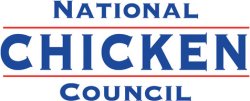 After many years of implementation, surveillance and evaluation in 54 plants, the USDA intends to finalize the rule that would allow line speeds in suitably equipped and managed plants to increase from 140 to 175 birds per minute. Studies have shown that increased line speed has not resulted in any deterioration in food safety or quality. In a January 4th article in the Washington Post, opposed the more extensive application of increased line speed based on a number of canards and misrepresentations.
After many years of implementation, surveillance and evaluation in 54 plants, the USDA intends to finalize the rule that would allow line speeds in suitably equipped and managed plants to increase from 140 to 175 birds per minute. Studies have shown that increased line speed has not resulted in any deterioration in food safety or quality. In a January 4th article in the Washington Post, opposed the more extensive application of increased line speed based on a number of canards and misrepresentations.
The latest justification to oppose the 175 birds per minute rate is the prevalence of COVID-19 in "meat plants". The Washington Post article cited a Food, Environmental Reporting Network (FERN) report as the basis for their concern. The FERN report documented results from 1,262 plants of which 565 were classified as "meat packing" recording 51,688 cases of COVID-19 with 263 fatalities.
 A review of the source document notes that there was no distinction between poultry-processing plants and meat-packing plants affected by COVID. In an attempt to differentiate between the red meat and poultry facilities, data on two major integrators, totally committed to chicken processing were extracted from the globular data in the FERN report. The first company in the top-five identified six cases in their Texas chicken plant and 94 in their North Carolina chicken plant. A second top-five company recorded 98 cases in a North Carolina plant, 256 in Minnesota and 283 in Arkansas.
A review of the source document notes that there was no distinction between poultry-processing plants and meat-packing plants affected by COVID. In an attempt to differentiate between the red meat and poultry facilities, data on two major integrators, totally committed to chicken processing were extracted from the globular data in the FERN report. The first company in the top-five identified six cases in their Texas chicken plant and 94 in their North Carolina chicken plant. A second top-five company recorded 98 cases in a North Carolina plant, 256 in Minnesota and 283 in Arkansas.
Raw data is misleading since comparisons can only be based on rates. Without knowing the total compliment of workers, supervisors, and managers in each plant, it is impossible to differentiate among companies, type of plant, location or size of operation.
 Tom Super, VP of Communications for the National Chicken Council noted that the line speed rule has been under consideration for three decades and over four administrations and has been the subject of considerable scientific study and litigation. Increasing line speed is consistent with higher levels of automation and mechanization as developed in the EU and applied on four continents. Increased mechanization reduces the need for workers and increased line speed justifies a capital investment in improved technology. Innovations including increased line speed in conjunction with HIMP will be necessary for the U.S. chicken industry to be competitive in world markets and to continue delivering wholesome chicken to domestic consumers. Conflating chicken plants with red meat plants without clear differentiation is essentially sophistry. To misapply data to oppose a progressive development is disingenuous.
Tom Super, VP of Communications for the National Chicken Council noted that the line speed rule has been under consideration for three decades and over four administrations and has been the subject of considerable scientific study and litigation. Increasing line speed is consistent with higher levels of automation and mechanization as developed in the EU and applied on four continents. Increased mechanization reduces the need for workers and increased line speed justifies a capital investment in improved technology. Innovations including increased line speed in conjunction with HIMP will be necessary for the U.S. chicken industry to be competitive in world markets and to continue delivering wholesome chicken to domestic consumers. Conflating chicken plants with red meat plants without clear differentiation is essentially sophistry. To misapply data to oppose a progressive development is disingenuous.